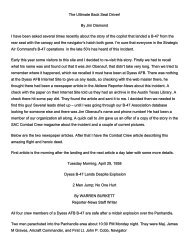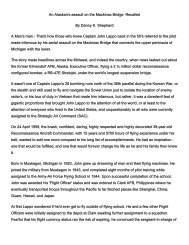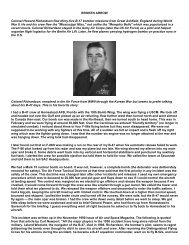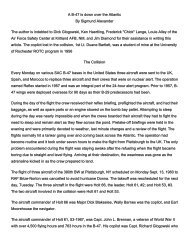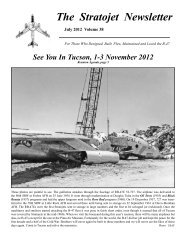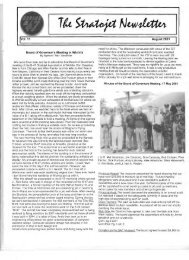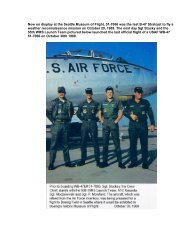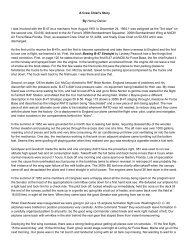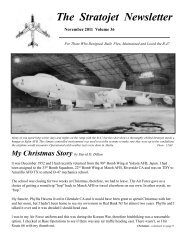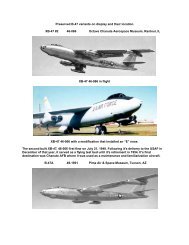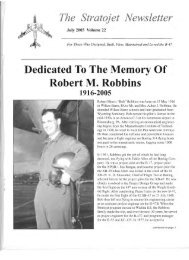The Stratojet Newsletter - The B-47 Stratojet Association
The Stratojet Newsletter - The B-47 Stratojet Association
The Stratojet Newsletter - The B-47 Stratojet Association
You also want an ePaper? Increase the reach of your titles
YUMPU automatically turns print PDFs into web optimized ePapers that Google loves.
Number 5<br />
Secretaries Report:<br />
It is hard to believe that another<br />
Thanksgiving has come and gone, and<br />
that Christmas is less than four weeks<br />
away. Since I have a lot to say, I'll get<br />
right to work.<br />
As has been the case for the past two<br />
years, the B-<strong>47</strong> <strong>Stratojet</strong> <strong>Association</strong> is<br />
growing at an impressive rate. We now<br />
have over 1000 members, and continue<br />
to receive inquiries on a daily basis.<br />
Since this is the Holiday Season, why<br />
not pass along the names of former B-<strong>47</strong><br />
crewmates whom you continue to<br />
exchange Christmas cards with? For<br />
those of you who have already sent in a<br />
Membership form, how about passing<br />
along a copy to a friend?<br />
Last issue, I mentioned that we had<br />
agreed not to raise <strong>Association</strong> dues, and<br />
that those of you who were paid up for<br />
<strong>The</strong> <strong>Stratojet</strong> <strong>Newsletter</strong><br />
December, 1998<br />
the year would find "98" in the bottom<br />
left corner of your mailing label.<br />
Unfortunately, the Post Office felt that<br />
placing a number on the bottom line of<br />
the label would confuse the ZIP CODE<br />
reader, and they requested that the year<br />
be moved to the upper left corner. So,<br />
from now on, you will find this<br />
information in the upper left corner of<br />
each newsletter. Sorry for any confusion<br />
this may have caused. Anyone who sent<br />
in more than one payment for 1998 has<br />
been credited for 1999 as well.<br />
Many thanks to those of you who have<br />
written to inform me of the letter in the<br />
recent OctoberlNovember issue<br />
Smithsonian Air & Space magazine<br />
promoting our organization. I would<br />
like to thank A &S editor George Larson<br />
for the plug which generated many new<br />
memberships.
New England Air Museum Trip<br />
On October 19 1h , 25 members of the<br />
<strong>Association</strong> met at the New England Air<br />
Museum in Windsor Locks, CT. with the<br />
hope that we would be allowed to board<br />
their WB-<strong>47</strong>E sin 51-2360 (see "<strong>Stratojet</strong>s<br />
on the Move" in the last newsletter for more<br />
information about this bird). After an<br />
interesting presentation by Museum Board<br />
Member David Isner, our group was led<br />
outside to the waiting B-<strong>47</strong>. <strong>The</strong> weather<br />
was perfect, and everyone lined up at the<br />
crew entry hatch and waited for their turn to<br />
climb aboard. For more than an hour, we<br />
took turns moving about the cockpit, sitting<br />
in the pilots, co-pilots and navigators seats.<br />
Ron Berniscone even crawled down the<br />
passage leading to the bomb bay for a look<br />
around. What a great way to spend a<br />
beautiful fall afternoon!<br />
Don Tynan in the AC seat<br />
President's Podium<br />
I am pleased to announce that the RB-<strong>47</strong>H<br />
sin on display at Eglin AFB, FL has been<br />
beautifully restored . <strong>The</strong> last time I saw it in<br />
1994, it was a dismal. looking aircraft,<br />
unkempt and badly in need of a paint job.<br />
Since then, it has been repainted and it<br />
glistens! This aircraft was formerly used as<br />
the radar testbed for the General Dynamics<br />
F-lll Aardvark, and it' s nose was modified<br />
to carry that radar. After completion of the<br />
F-ll1 test program, the nose was refitted<br />
with an "E" model bomber nose in lieu of<br />
the familiar fiber glass nose which was<br />
2<br />
standard on the RB-<strong>47</strong>Hs. <strong>The</strong> nose was<br />
painted black to simulate the original nose<br />
of the RB-<strong>47</strong>H.<br />
100 lh BW Reunion<br />
<strong>The</strong> 100 lh Bomb Wing held its sixth reunion<br />
since the wing was deactivated in 1966 at<br />
the Ramada Plaza Beach Resort at Fort<br />
Walton Beach, FL from October 28 to<br />
November 2. <strong>The</strong>re were over 180<br />
attendees, among them Colonel Andreas A.<br />
Andrae, the first wing commander; Colonel<br />
Jim Howard, the last wing commander; and<br />
Major General Leo Lewis, the first DO of<br />
the wing. As with every reunion it was sad<br />
to note the husbands and wives that have<br />
passed away since the last reunion.<br />
Charlie Brown and his team did an<br />
outstanding job of planning. <strong>The</strong>re was<br />
golf, shopping, fishing, Gulfarium and trips<br />
to the Navy Museum at Pensacola, Hurlburt<br />
Field, and the Armament museum. <strong>The</strong><br />
Oasis bar next to the pool served as the<br />
hospitality room for the reunion and was<br />
open almost continuously.<br />
<strong>The</strong> highlight of the reunion was the<br />
Saturday night Luau where a great meal was<br />
served. <strong>The</strong> next 100 lh BW reunion will be<br />
held in 2000 with the place and the exact<br />
date to be determined58 19.<br />
<strong>The</strong> 50'" Anniversary of the Reactivation<br />
of the 306 1h BW<br />
1999 will mark the 50 th anniversary of the<br />
reactivation of the 306 1h BW. <strong>The</strong> 306 1h at<br />
MacDili became the first wing in the Air<br />
Force to receive the B-<strong>47</strong> and was<br />
commanded by Colonel Michael N . McCoy.<br />
<strong>The</strong> next issue of the newsletter will feature<br />
an article on the early days of the 306 1h BW.
esponsibility of the field shop. After a<br />
mission, which involved firing, the guns had<br />
to be removed, cleaned, and reinstalled. On<br />
landing, the copilot was responsible for<br />
visually checking the guns to insure they<br />
were empty. <strong>The</strong> incident involving the<br />
guns occurred shortly after a 0730 roll call<br />
when we were dismissed earl ier than usual.<br />
After being dismissed, we proceeded to the<br />
dispatch room when we heard a loud bang<br />
followed by the sound of a metal object<br />
ricocheting down the ramp. <strong>The</strong> mechanic<br />
responsible for checking the firing circuit<br />
had incorrectly laid the barrels down facing<br />
the ramp and did not check to see if the guns<br />
were clear. When he proceeded to check the<br />
firing circuit, the round in the gun was fired<br />
and went through a truck on the loading<br />
ramp and it ended up spent next to a<br />
mechanic working on an engine. If the<br />
morning formation had not been dismissed<br />
earlier than usual, the round would have tom<br />
through some of those who were standing in<br />
the formation . No one can predict what fate<br />
has in store for us.<br />
Off duty, we headed for the "Korina" which<br />
was the most unusual bar I have ever been<br />
in. lt was located in the last house on a<br />
street with a string of almost identical Cape<br />
Cod cottages. This was the 380 lh hangout<br />
and we filled it every night. <strong>The</strong> bartender<br />
was a double for the actor Edmund O'Brien,<br />
and he knew what everyone drank. <strong>The</strong><br />
380 lh drank beer and lots of it. When there<br />
was a promotion party, we kept the empty<br />
cases of the beer which had been drunk in<br />
the corner of what was the living room and<br />
it was not unusual to see two or more stacks<br />
of cases reaching to the ceiling.<br />
"Arabella's" in Keesport was a minor<br />
hangout for the weapons guys since a<br />
number of sergeants lived in the town .<br />
Though not in the National Register of<br />
Historic Places, "Arabella's" began as a<br />
speakeasy house during prohibition .<br />
I was for1unate to go with the wing when<br />
they deployed to Brize Norton for 90 days.<br />
It was a tour that I thoroughly enjoyed. My<br />
duties were the same as those at Plattsburgh,<br />
4<br />
mainly changing the reconfiguration of the<br />
special weapons rack when the weapon was<br />
changed.<br />
Off duty, I went to the local villages for a<br />
pint where I made some great friends with<br />
members of the Royal Signal Corps. I had<br />
fun playing darts and downing a few pints,<br />
and on weekends there was time to go to<br />
London .<br />
In a chow line at Brize, I ran into a kid who<br />
I had not seen since the third grade, small<br />
world. Not all was merry in England.<br />
While there, I picked up a case of hay fever,<br />
which was so severe that for a time my eyes<br />
were swollen shut.<br />
<strong>The</strong>re was an amusing incident, which<br />
occurred while we were at Brize, which<br />
involved the Air Police. At the time both air<br />
and ground crewmen in SAC wore leather<br />
hats, our squadron's hats were black with<br />
380 AE in orange across the front. <strong>The</strong> cops<br />
were picking up members of our squadron<br />
for being out of uniform. We were released<br />
only after our commander had interceded<br />
and the cops were made aware that the cap<br />
was part of the uniform.<br />
I returned to Plattsburgh on a beautiful<br />
Lockheed Constellation. What awaited me<br />
was winter as only winter can get in upstate<br />
New York. I wore Arctic clothing on the<br />
flight line with bunny boots. Working on<br />
the flight line, we had to constantly check<br />
one anOlher for frostbi Le. It was so cold that<br />
a cup of hot coffee would freeze while<br />
walking from the bomb bay to the tail. If<br />
you spit, your spittle would freeze before it<br />
reached the ground and bounce when it hit.<br />
Cars in the parking lot disappeared under a<br />
mountain of snow. <strong>The</strong> first priority for<br />
snow removal was that of the clearing the<br />
runway where four Walter snowplows raced<br />
in formation up and down the runway at 40<br />
miles per hour. At times the ramp would be<br />
covered in ice following an ice storm which<br />
caused trucks to move more sideward than<br />
frontward. <strong>The</strong> ever-resourceful crew chiefs<br />
used ice skates to travel up and down the
amp. <strong>The</strong>re are many pleasant memories I<br />
have of Plattsburgh but winter is not one of<br />
them.<br />
When my tour was LIp, I contemplated going<br />
to OCS and staying in. However, after<br />
seeing what a Boeing tech rep made, I<br />
decided to go to the Aeronautical School at<br />
Boston University. A'fter all these years I<br />
am proud of having served in SAC and the<br />
8 th Air Force. <strong>The</strong>se were some of the finest<br />
years of my life!<br />
In 1986, I made a nostalgic return trip to<br />
Plattsburgh where I visited Arabella's. I<br />
thought I was in the Twilight Zone, nothing<br />
had changed. <strong>The</strong> shuffleboard table was<br />
still there, the same guy was on the same bar<br />
stool drinking, although he was older, and<br />
the floor was still wet in the men's room.<br />
"Cold War in Flames"<br />
By Sigmund Alexander<br />
On September 12, 1998 a symposium on<br />
Cold War manned reconnaissance<br />
entitled "Cold War in Flames" was<br />
held at the new SAC museum in Omaha,<br />
Nebraska. <strong>The</strong> objective of the<br />
symposium was to present an historical<br />
perspective on the role of manned<br />
reconnaissance flights during the Cold<br />
War, and to honor the airmen of the Air<br />
Force and Navy who carried out this<br />
hazardous mission.<br />
<strong>The</strong> meeting was hosted by Robb<br />
Hoover, a former 55th Strategic<br />
Reconnaissance Wing RB-<strong>47</strong>H<br />
electronic warfare officer. <strong>The</strong> 200-seat<br />
auditorium was filled to capacity and<br />
among those in the audience were<br />
survivors of Soviet fighter attacks and<br />
families of those who were killed in<br />
these attacks. Survivors included John<br />
Roche, the AC, and only survivor of a<br />
17-man RB-50 crew shot down off the<br />
5<br />
coast of Vladivostok on July 29, 1953;<br />
and Don Sonnet, an ordinance man on a<br />
P2-V5 Neptune attacked by MiGs on<br />
June 22, 1955, which subsequently crash<br />
landed on St. Lawrence Island in the<br />
Bering Straits. Fortunately all<br />
crewmembers survived. Hank Douby,<br />
copilot; Hank Rogers, navigator; and<br />
George Back, EW, of RB-<strong>47</strong>H crew E<br />
96, which successfully fended off North<br />
Korean MiG-17s over the Sea of Japan<br />
in April 1965. Family survivors<br />
included Maria Goforth McAffee,<br />
widow of EW Oscar Lee Goforth, and<br />
Patricia and Roxanne Phillips, widow<br />
and daughter of EW Dean Phillips. Both<br />
Goforth and Phillips were crewmembers<br />
on the RB-<strong>47</strong> H which was shot down<br />
over the Barents Sea on July 1, 1960.<br />
Survivors of this attack were lieutenants<br />
Bruce Olmstead and John McKone.<br />
"Cold War In Flames" Participants<br />
<strong>The</strong> first speaker was Lt. Colonel John<br />
T. Farquar, Associate Professor of<br />
History at the Air Force Academy.<br />
Farquar covered the initial development<br />
of reconnaissance of the Soviet Union<br />
following the end of World War II when<br />
it became apparent that the Soviet Union<br />
may be an opponent in a future war. He<br />
covered the period from 1945 to 1948.<br />
In 1946, reconnaissance was a jury rig<br />
haphazard affair utilizing B-17s. Project<br />
Nanook flying out of Eielson AFB,<br />
Alaska in 1946 mapped northern
Greenland and searched for signs of<br />
Soviet radars in the vast Arctic expanse.<br />
In August 1946, following the shooting<br />
down of an American C-<strong>47</strong> by Yugoslav<br />
fighters, a B-17 was outfitted as a ferret<br />
to detect Yugoslav radars. <strong>The</strong> B-17 was<br />
successful in ascertaining that the<br />
Yugoslavs were using captured German<br />
W urzburg radar.<br />
During the Berlin airlift, a B-17 ferret<br />
flew in between the transpo11s ferrying<br />
food and fuel to Berlin to acquire<br />
intelligence on Soviet radars. <strong>The</strong> B-17<br />
never landed at Berlin. It notified the<br />
tower that it was having difficulties, and<br />
would have to return to its home base.<br />
By the end of 1949, reconnaissance and<br />
intelligence gathering had become<br />
systematized in a concerted effort to<br />
obtain information about potential<br />
targets within the Soviet Union, and the<br />
nature of the country's air defense<br />
network including radar. A former<br />
German Gehlen intelligence team was<br />
recruited to work for the United States,<br />
and both Air Force and Navy aircraft<br />
were flew along the perimeters of the<br />
USSR to glean information on their early<br />
warning and GCI radars.<br />
Though America alone possessed the<br />
atomic bomb, the number of atomic<br />
weapons in the American nuclear<br />
stockpile were pitifully small. In 1945<br />
the United States possessed two bombs,<br />
nine in July 1946, thirteen in July 19<strong>47</strong>,<br />
and fifty by July 1948. Moreover these<br />
early weapons were not immediately<br />
ready for use but had to be armed. This<br />
required several hundred personnel, and<br />
involved considerable time. Initial JCS<br />
war plans were drawn up in 1946 to<br />
counter a possible Soviet attack on the<br />
West, and intelligence and<br />
6<br />
reconnaissance were directed to obtain<br />
the necessary information to carry out<br />
these war plans.<br />
Greg Skavinski, a contracting officer<br />
with the CIA, addressed the issue of the<br />
fate of airmen lost on ten American<br />
aircraft shot down from 1950 to 1965.<br />
Greg's interest in the topic stems from<br />
trying to learn the facts surrounding an<br />
uncle killed when his RB-29 was shot<br />
down over the Sea of Japan on June 13,<br />
1952. Over the years, the Pentagon was<br />
reluctant to discuss the loss of<br />
reconnaissance aircraft, which they<br />
classified as non-combat related.<br />
However, as a result of the efforts of<br />
Greg and others, the Air Force finally<br />
admitted that the losses were combat<br />
related and subsequently awarded Purple<br />
Hearts and Distinguished Flying Crosses<br />
to all of the men who were killed.<br />
Greg has created an exhibit depicting<br />
each of the ten shootdowns along with<br />
other artifacts related to Cold War<br />
reconnaissance. CIA graphid and<br />
training aids assisted Greg in the<br />
creation of this exhibit which was<br />
displayed at the CIA, the Defense<br />
Intelligence Agency (DIA), and the<br />
National Security Agency (NSA). Greg<br />
has donated the exhibit to the SAC<br />
Museum for permanent display.<br />
Former lieutenants Bruce Olmstead and<br />
John McKone, now retired colonels,<br />
retold their stories of being shot down<br />
over the Barents Sea on July 1, 1960;<br />
their subsequent ejection, survival and<br />
rescue from the frigid sea, imprisonment<br />
and interrogation in the Lubiyanka<br />
prison, and their eventual release. Both<br />
stated that it was President Kennedy's<br />
personal intervention to Khrushchev,<br />
which secured their freedom.
Crewmembers lost were Major Palm,<br />
the AC and the two EWs, Goforth and<br />
PhiHips.<br />
Lt. Serge Sherman, USN of the missing<br />
POW office in the Pentagon briefly<br />
addressed the group regarding efforts to<br />
resolve the fate of crewmembers lost in<br />
the various shootdowns. Lt. Sherman<br />
stated there is little possibility of closure<br />
since the Soviet system was based on<br />
duplicity and finding the truth is<br />
impossible.<br />
Gary Powers Jr., who has an uncanny<br />
resemblance to his deceased father, told<br />
the story of his father's shoot down, and<br />
how his own life was affected by his<br />
father's U-2 flight. <strong>The</strong> high regard that<br />
Gary had for his father is manifested in<br />
his efforts to build both a Cold War<br />
memorial near Arlington National<br />
Cemetery and a Cold War museum.<br />
Francis Gary Powers, Jr.<br />
<strong>The</strong> final presentation was made by Dr.<br />
Robert Hopkins who covered the<br />
importance that manned aircraft played<br />
in debunking the so called missile gap,<br />
and defusing crises in both the Middle<br />
7<br />
East and the islands of Quemoy and<br />
Matsu in the late fifties.<br />
Robb Hoover closed the meeting with a<br />
quote from a speech that Ronald Reagan<br />
made in January 1988. "We must never<br />
forget that freedom is never free. It is<br />
the most costly thing in the world. And<br />
freedom is never paidfor in a lump sum.<br />
Installments come due in every<br />
generation. All any ofus can do is offer<br />
the generations that follow a chance for<br />
freedom." Unrelated to the symposium,<br />
but pertinent to a long overdue<br />
recognition for those who flew manned<br />
reconnaissance missions, the CIA<br />
honored U-2 pilots in a ceremony at Ft.<br />
McNair, DC on September 17,1998.<br />
<strong>The</strong> Last Word<br />
Over the past year, I have received many<br />
requests to add members email addresses<br />
to the roster. I have been reluctant to do<br />
this without first obtaining everyones<br />
permission. Since we now have several<br />
hundred members with e-mail addresses,<br />
it is not practical for me to try to contact<br />
each of you personally to ask for your<br />
permission. <strong>The</strong>refore, I would like to<br />
take this opportunity to ask everyone<br />
who DOES NOT wish to have their email<br />
address made available to the group<br />
to contact me. If I do not hear from you,<br />
then your email address will be<br />
published in the next newsletter.<br />
B-<strong>47</strong> reunion-2000<br />
Dick Purdum and Don MaIm will be<br />
hosting the <strong>Association</strong>s next reunion,<br />
which will coincide with the annual<br />
Confederate Air Force air show in<br />
Midland, Texas in October 2000. Dick<br />
would like to hear from those of you<br />
who feel you might attend. He can be
o<br />
In April of 1951, Boeing recei ved a contract for the modification of two B<br />
<strong>47</strong>Bs as flying turboprop testbeds under the designation XB-<strong>47</strong>D. <strong>The</strong> two<br />
B-<strong>47</strong>Bs selected for the conversion were serial numbers 51-2103 and 51<br />
2046. <strong>The</strong>y retained the outboard 1<strong>47</strong> -GE-23 jet engines of the B-<strong>47</strong>B, but a<br />
single Curtiss-Wright YT49-W -1 turboprop of 971 0 equivalent shaft<br />
horsepower occupied each of the inboard underwing nacelles in place of the<br />
paired 1<strong>47</strong>s.<br />
(excerrt 1"(,(1111 Joe Baughers's hi story of the B-.+7 Stratojd)
B-<strong>47</strong> <strong>Stratojet</strong> <strong>Association</strong><br />
23 Oak Ridge Road<br />
W. Lebanon, NH 03784<br />
NON-PROFIT ORG.<br />
U.S. POSTAGE PAID<br />
LEBANON, NH<br />
PERMIT NO. 41 1



